

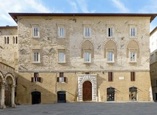
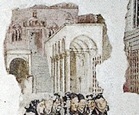
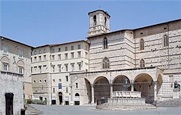
Palazzo Vescovile Loggia di Braccio and Stranded Loggia di Braccio
incorporates part of the now-demolished after Palazzo del Podestà
Palazzo del Podestà Palazzo del Podestà burned down in 1534
on the right Palazzo Vescovile is to the left
The illustration at the centre, above, is a detail of a fresco (late 15th century) by Benedetto Bonfigli in the Cappella dei Priori (now part of the Galleria Nazionale). It shows the Loggia di Braccio, which ran along the left wall of the Duomo and continued to the entrance to the Palazzo del Podestà (below). It became “stranded” when this palace burned down in 1534.
Palazzo del Podestà (13th century)
Structure of Government
The first documentary evidence of a secular government of Perugia dates to 1139, when the citizens of Isola Polvese submitted to Perugia, which was represented by twelve Consuls. The office of Podestà (an outsider serving as the head of the government for short period) was probably instituted in the 1190s.
The office of Podestà was retained after 1255, when the parallel magistracy of the Capitano del Popolo was initiated. A tower house on the other side of Palazzo Vescovile that was rented to accommodate the new organ of government.
Initial Construction (1205-7)
In the time of the Podestà Giovanni di Guido del Papa (1205-6), the Commune commissioned a palace between the Duomo and Palazzo Vescovile to provide premises for the administration of the Commune and accommodation for the Podestà and his entourage. This necessitated the acquisition and demolition of properties that belonged to the canons of San Lorenzo (see Palazzo dei Canonici). They successfully appealed to Pope Innocent III for the restitution, but decided to accept the situation in return for compensation in 1208.

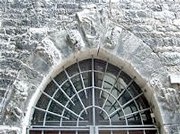

The tower house at number 14 Via Ritorta, which is behind the present Palazzo Vescovile (see below for Palazzo Vescovile and Walk III for Via Ritorta) incorporates architectural fragments (illustrated above) that might well have belonged to this palace. The arch over the portal has interesting reliefs of a horse (or perhaps a donkey) on the left, a griffin on the right, and other animals above that are too damaged to identify.
The Podestà and his entourage vacated the palace in 1235, to make way for Pope Gregory IX, and again in 1251-3 to make way for Pope Innocent IV. At these times, the Commune held its meetings in the Duomo.
Extension (1282-92)
The first discussion of the possibility of building a new palace for this magistracy seems to have taken place in 1273. However, the project had to give way to another for bringing an adequate supply of water to the city centre. (This culminated in the construction of the Fontana Maggiore in 1278 and Fontana Minore in 1281). The decision was taken in 1279 to acquire the land and buildings necessary for the extension of the existing Palazzo del Podestà and the building of a new palace (later known as the Palazzo dei Priori) for the Capitano del Popolo.
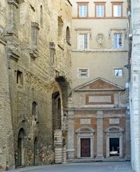
Part of Palazzo dei Canonici itself seems also to have been incorporated into Palazzo del Podestà at this time, notwithstanding the objections of the canons. The project seems to have been complete by 1292, albeit that further internal work was carried out in 1297.
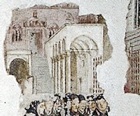
Later History
The palace was largely rebuilt after a fire in 1329: the traces of three Gothic windows on the first floor of Palazzo Vescovile (below) probably came from the 14th century rebuilding. Other traces of the earlier palaces can be seen at the back of the present structure, in Via Ritorta.
Braccio Fortebracci occupied this palace during the time he was Lord of Perugia (1414-24). He built the loggia (1423) shown in the fresco detail above, which is known as the Loggia di Braccio.
The palace was later used by the papal governors of Perugia. It was burned down in 1534, when Ridolfo Baglioni took Perugia and murdered the papal representative, Cinzio Filonardi, who was living here.
Palazze Seminario e Vescovile (1654-8)
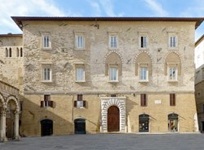
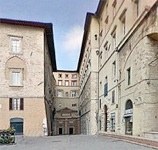
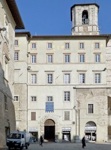
Palazzo Vescovile Chiesa della Maestà delle Volte Palazzo del Seminario
Pope Pius IV allowed Cardinal Bishop Fulvio della Corgna to take possession of the ruins of the ex-Palazzo del Governatore so that he could use the site for two buildings that were needed to fulfil the requirements of decrees (1563) of the Council of Trent:
-
✴the episcopal seminary, for the education of clerics, in front of Palazzo dei Canonici; and
-
✴the new Palazzo Vescovile, to facilitate compliance with the rule that bishops should reside in their dioceses.
Episcopal Seminary
The episcopal seminary of Perugia was one of the first to be established in Italy and it had a notably high level of educational aspiration. Cardinal della Corgna contributed from his own resources, and he also pressed the city’s monasteries to assist in the enterprise.
He transferred the Chiesa della Maestà delle Volte to the seminary, having demolished the surviving steps to the old Palazzo del Podestà and widened what had been the vaulted alley under it to provided a more fitting entrance to the church.
Palazzo Vescovile
The extent of the initial work on the new Palazzo Vescovile carried out by Cardinal della Corgna is unclear. However, he was able to accommodate the Jesuits from their arrival in Perugia in 1551 until some time after 1561, when the acquired the site of the Chiesa del Gesù.
Cardinal Bishop Antonio Maria Gallo (1586-91) is known to have carried out improvements to the palace.
As noted above, the three windows to the right on the first floor of Palazzo Vescovile probably belonged to the 14th century rebuilding of Palazzo del Podestà. The left part of the building stands on the site of the old Palazzo Vescovile. (The two bifore windows in the top floor of the building to the left might have belonged to the earlier palace).
A photograph of the present Palazzo Vescovile taken in the 1920s (included in the excellent website “Old Perugia”) show its facade covered by black and white frescoes, but these were removed in a subsequent restoration.
Read more:
A. Bartoli Langeli and M. Silvestrelli, “Il Comune Duecentesco e i Suoi Palazzi”, in
F. Mancini (Ed), “Il Palazzo dei Priori di Perugia”, (2000) Perugia, pp 3-12
M. Silvestrelli, “La Città Medievale: Edifici, Vie e Piazze”, in
R. Rossi (Ed), “Storia Illustrata delle Città dell' Umbria: Perugia”, (1993) Milan, pp 145-60
Return to Monuments of Perugia.
Return to Walk I or
(for the back of Palazzo del Podestà and Palazzo Vescovile) Walk III.

